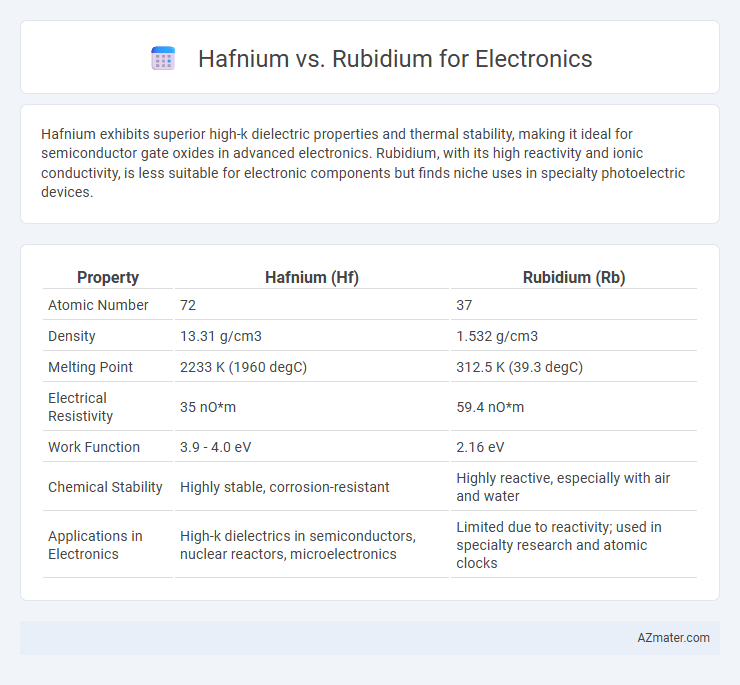Hafnium exhibits superior high-k dielectric properties and thermal stability, making it ideal for semiconductor gate oxides in advanced electronics. Rubidium, with its high reactivity and ionic conductivity, is less suitable for electronic components but finds niche uses in specialty photoelectric devices.
Table of Comparison
| Property | Hafnium (Hf) | Rubidium (Rb) |
|---|---|---|
| Atomic Number | 72 | 37 |
| Density | 13.31 g/cm3 | 1.532 g/cm3 |
| Melting Point | 2233 K (1960 degC) | 312.5 K (39.3 degC) |
| Electrical Resistivity | 35 nO*m | 59.4 nO*m |
| Work Function | 3.9 - 4.0 eV | 2.16 eV |
| Chemical Stability | Highly stable, corrosion-resistant | Highly reactive, especially with air and water |
| Applications in Electronics | High-k dielectrics in semiconductors, nuclear reactors, microelectronics | Limited due to reactivity; used in specialty research and atomic clocks |
Introduction to Hafnium and Rubidium in Electronics
Hafnium is a transition metal widely used in semiconductor technology due to its high dielectric constant, enhancing the performance of gate oxides in microchips and reducing leakage currents in transistors. Rubidium, an alkali metal, finds niche applications in electronics such as atomic clocks and photoelectric devices because of its unique atomic properties and ability to improve frequency stability. The integration of hafnium in advanced CMOS devices contrasts with rubidium's specialized roles, highlighting their distinct contributions to electronic innovation.
Elemental Properties: Hafnium vs Rubidium
Hafnium, a transition metal with atomic number 72, exhibits high melting point (2,233degC) and excellent corrosion resistance, making it ideal for high-temperature electronics and semiconductor devices. Rubidium, an alkali metal with atomic number 37, has a low melting point (39.3degC) and is highly reactive, limiting its direct use in electronics but valuable in specialty applications like atomic clocks and photodetectors. The contrasting elemental properties--hafnium's stability and conductivity versus rubidium's reactivity--dictate their distinct roles in advanced electronic components.
Occurrence and Availability in Nature
Hafnium is a transition metal primarily found in zirconium minerals, with an average crustal abundance of about 5.8 ppm, making it relatively rare but consistently available through zirconium mining. Rubidium, an alkali metal with a crustal abundance of approximately 90 ppm, occurs in small quantities within minerals such as lepidolite and pollucite, but its extraction is less concentrated and more sporadic. While hafnium's occurrence tied to zirconium-rich deposits ensures a stable supply for electronics, rubidium's scattered distribution leads to more limited and variable availability for electronic applications.
Electrical Conductivity Comparison
Hafnium exhibits significantly higher electrical conductivity compared to rubidium, making it a preferred material in high-performance electronic components. Its metallic structure provides efficient electron flow, essential for applications requiring stable and reliable conductivity at elevated temperatures. Rubidium, while useful in some specialty applications, has lower conductivity and reactivity issues that limit its effectiveness in mainstream electronics.
Key Applications in Modern Electronics
Hafnium is vital in modern electronics due to its high dielectric constant, making it a preferred material for gate insulators in advanced CMOS transistors, enhancing device performance and scaling. Rubidium's use in electronics is primarily in specialized atomic clocks and quantum computing components, benefiting from its stable isotope properties for timekeeping and signal processing precision. The distinct electronic and physical properties of hafnium and rubidium dictate their respective roles in semiconductor technology and advanced quantum electronics.
Performance in Semiconductor Devices
Hafnium outperforms rubidium in semiconductor devices due to its high dielectric constant and excellent thermal stability, making it ideal for high-k gate dielectrics in advanced transistors. Rubidium, with its larger ionic radius and lower melting point, is less suitable for high-performance electronics but can serve niche roles in optoelectronic components. In terms of carrier mobility and device scaling, hafnium-based materials significantly enhance transistor speed and reduce power consumption compared to rubidium-based alternatives.
Stability and Reactivity in Electronic Components
Hafnium exhibits exceptional chemical stability and corrosion resistance, making it ideal for high-performance electronic components such as capacitors and transistors, especially in extreme environments. Rubidium's high reactivity and low melting point limit its use in electronics, as it can quickly degrade materials and cause instability in circuits. Hafnium's stable oxide layers and resistance to thermal stress enhance the longevity and reliability of electronic devices compared to the more reactive rubidium.
Cost Analysis and Material Sourcing
Hafnium, widely used in semiconductor manufacturing for its excellent dielectric properties, generally commands a higher price than rubidium due to its rarity and complex extraction process from zirconium ores. Rubidium, primarily sourced from lepidolite and pollucite minerals, is more abundant and less costly but sees limited application in electronics, mainly in research and specialty devices like atomic clocks. Cost analysis favors rubidium for niche uses where price sensitivity is crucial, whereas hafnium remains indispensable despite higher expenses due to its superior performance in integrated circuits and transistor gate dielectrics.
Environmental and Safety Considerations
Hafnium exhibits superior corrosion resistance and stability, making it safer for use in high-performance electronics with minimal environmental impact during disposal. Rubidium is highly reactive and poses significant safety risks due to its violent reaction with water, requiring rigorous handling protocols and controlled environments to prevent hazardous incidents. The environmental footprint of hafnium remains lower, as rubidium compounds may contribute to soil and water contamination if improperly managed.
Future Trends and Innovations in Electronic Materials
Hafnium's high dielectric constant and thermal stability make it crucial for advanced semiconductor gate oxides, driving innovation in next-generation transistors. Rubidium, less common in electronics but influential in photonics and quantum computing, shows potential for breakthroughs in optoelectronic materials and quantum sensors. Future trends emphasize hafnium-based high-k dielectrics and rubidium-enhanced quantum devices, highlighting their complementary roles in evolving electronic material technologies.

Infographic: Hafnium vs Rubidium for Electronics
 azmater.com
azmater.com